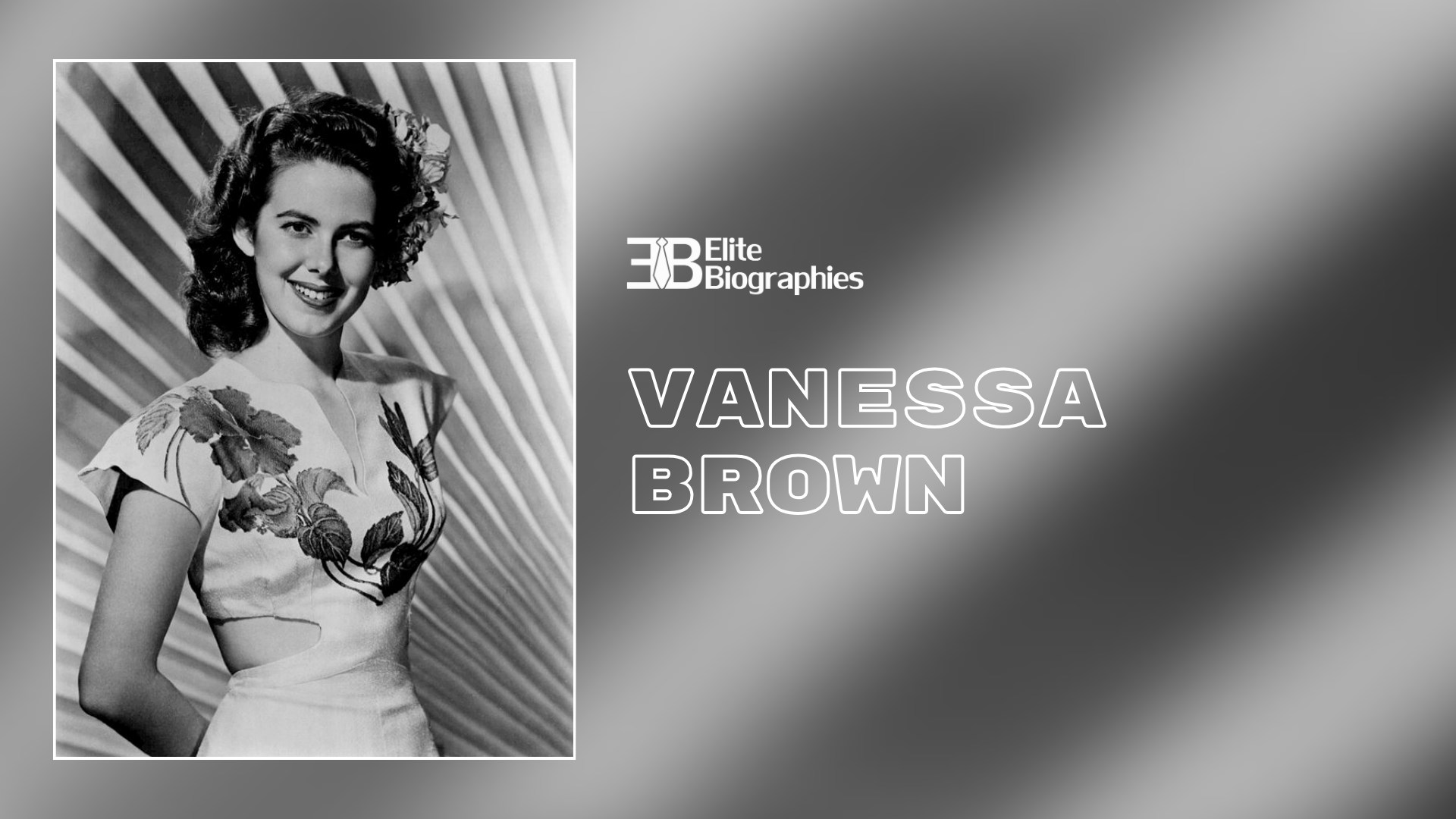Vanessa Brown

Vanessa Brown was an Austrian-American actress renowned for her poise, talent, and captivating performances on stage and screen. With a career spanning several decades, Vanessa left an indelible mark on the entertainment industry, remembered for her versatility and depth as an actress.
Early life
Vanessa Brown was born to Jewish parents in Vienna, Austria — her father Nah Brind, a language teacher, and her mother Anna Brind, a psychologist. In 1937, the family escaped the Nazi regime’s persecution, initially moving to Paris, France.
A few years later, they traveled to America, where Brown went to Lillian Hellman’s casting call for a role in “Watch on the Rhine.” Hellman was impressed by her multilingualism, which led to her being chosen to be Ann Blyth’s understudy and ultimately playing Babette on Broadway and in the touring production of the play.
She participated in playwriting and directing while in high school. She went on to study at the University of California, Los Angeles, where she graduated in 1949 with a degree in English. She also contributed to the Daily Bruin, the school newspaper, as a feature writer and movie reviewer while attending UCLA.
Career
During the Hollywood film industry’s golden age, the 1940s and 1950s, Vanessa Brown’s career took off. Her roles in theater and movies brought her recognition very fast. Audiences and critics alike praised Vanessa for her versatility in portraying a wide range of personalities.
Vanessa collaborated with some of the most well-known actors and directors of her day during her career. She had a successful career as an actor, working on stage, television, and radio thanks to her talent and commitment to her profession.
Radio
Vanessa Brown, a bright young panelist on the radio series “Quiz Kids,” demonstrated her literary and linguistic expertise for two years, during which time her IQ of 165 was raised. Later in life, she shared her knowledge with a wider audience as the host of an interview program on Voice of America.
Being a well-known radio personality, she was featured on several other esteemed radio shows, such as “Lux Radio Theatre,” “Skippy Hollywood Theatre,” “NBC University Theatre,” and “Theatre Guild on the Air,” using her voice.
Film
As a junior member of the National Board of Review, Brown contributed her critical acumen to the motion picture industry. Her family relocated to Los Angeles courtesy of RKO Radio Pictures, which led to her cinematic debut in “Youth Runs Wild” (1944) under the name Tessa Brind. Subsequently, RKO rebranded her as Vanessa Brown, casting her in a variety of young leading lady roles.
Her filmography in the late 1940s was impressive, featuring in titles like “The Late George Apley” (1947), “The Ghost and Mrs. Muir” (1947) where she played Mrs. Muir’s adult daughter Anna, and “Big Jack” (1949), which was Wallace Beery’s final film. Her role in “The Heiress” (1949) further solidified her position in the industry.
Notably, she portrayed Jane in “Tarzan and the Slave Girl” (1950) opposite Lex Barker and appeared in Vincente Minnelli’s “The Bad and the Beautiful” (1952). Her final film role was in the horror movie “The Witch Who Came from the Sea” (1976), where she played Millie Perkins’s sister.
Television
Throughout the 1950s, Vanessa Brown made her mark on television as a frequent panelist on CBS’s “I’ll Buy That.” She showcased her acting skills in early live TV dramas such as “Robert Montgomery Presents” and “The Philco Television Playhouse,” and made appearances on shows like “Pantomime Quiz” and “Leave It to the Girls.” Her talent continued to shine in later years with roles in series like “The Wonder Years” and “Murder, She Wrote.” In the episode “The Sally Potter Story” of “Wagon Train” (S1E28), aired on April 9, 1958, she starred as the titular character with a young Martin Milner as her romantic lead. Her guest role as Donna Kress in “The Case of Paul Drake’s Dilemma” (1959) on “Perry Mason” further exemplified her versatile acting capabilities.
Stage
Brown returned to the Broadway stage as the original “The Girl” in “The Seven Year Itch,” a role that Marilyn Monroe famously played in the film adaptation in 1955. Throughout the 1950s, she remained active in television and lent her voice as a narrator for the United World Federalists documentary “Eight Steps to Peace” (1957), alongside Vincent Price and Robert Ryan.
Her artistic talents extended to writing for the stage as well, evidenced by her play “Europa and the Bull,” inspired by the myth of Europa.
Painting
By 1959, Brown had also established herself as a promising artist. A newspaper article from that year lauded her oil paintings, which adorned the homes of notable film industry figures. She signed her artworks with her birth name, Smylla. Her artistic prowess was recognized with a solo exhibition of her work at a Beverly Hills gallery in 1958, further highlighting her multifaceted talents.

Net Worth
While specific details about Vanessa Brown’s net worth at the time of her passing are not readily available, her successful career in Hollywood and theater likely afforded her a comfortable lifestyle. Her earnings would have been a reflection of her roles in various productions and her status in the entertainment industry.
Achievement
Here are some highlights from Brown’s life and career achievements.
These points reflect her journey from a young immigrant fleeing persecution to a talented and recognized actress and writer.
Related Bios

Vinh Giang
Primarily known as a world-class keynote speaker and magician, Vinh Giang is also an entrepreneur several times over, ha...
Read More
Mick Ebeling
Mick Ebeling is a producer, author, entrepreneur, technological trailblazer, and philanthropist. He is best known as the...
Read More
J.C. Hallman
John Christopher Hallman, known professionally as J.C. Hallman, is a critically acclaimed American author of both fictio...
Read More
Sal Godoij
Sal Godoij is a dedicated and seasoned writer with a career spanning over 23 years in the publishing industry. His works...
Read More
SOCIAL PROFILE
Not relevant, as she died before the age of social media. There are fan sites and accounts available today.